March 2009 archives
you are here [x]: Scarlet Star Studios > the Scarlet Letters > March 2009
<< before
February 2009
after >>
April 2009
March 31, 2009
paintings from december
by sven at 7:00 am
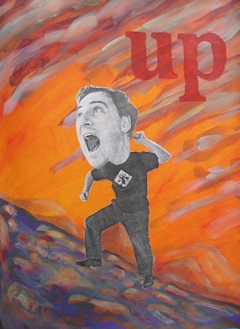
Back in December I was doing a lot of paintings in my sketchbook. I've been meaning to post a sampling for a long while now.
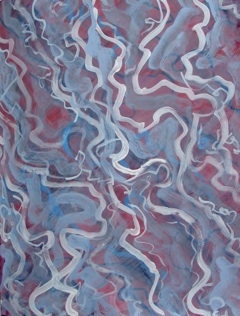
I was finding that abstracts were a nice way to warm up the visual part of my brain. Lately, though, the painting energy's been getting spent on birthday cards.
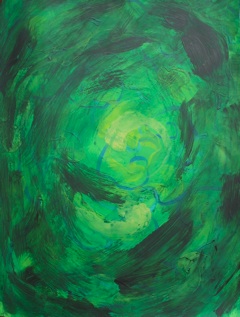
As you can probably tell, these are all improvised pieces. I only have the roughest idea of what I'm going to do when I start out.
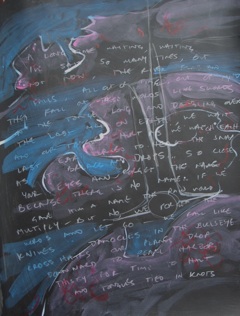
The text reads: "A long time waiting, waiting I've said so many times, but not now, the river flows and falls… All out of time, out of mind, then fall out, these words like swords on the tongue, long and dangling over the last man on Earth, we wait and our tongues hurt as we watch each last ear turned to hear the snap as it breaks and drops… So close your eyes and forget the name because there is no name… If we gave him a name the pain would multiply -- but no, we forget the words and let go -- we fall like knives. Damocles in the bull's-eye crosshairs, our planes drop downward to Pearl Harbor, thirsty for time to halt and tongues tied in knots."
It's stream-of-consciousness writing, largely there for texture. (Also a little shout out to Grant, whose film "The Sword of Damocles" popped to mind.)
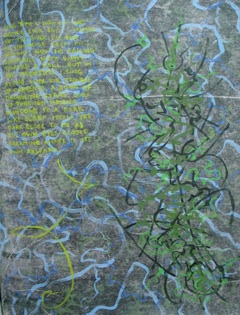
Text: "Long time I waited -- does waiting ever pay? I waited but the river did not. So unhitched from my moorings now I'm falling downhill with water toward a fall. But in the meantime I sing along with the trouble of currents, a song of drowning stars. Look up through moving windows to a dark like sleep itself, yes dark close to me as my own eyes closed. Dreaming awake is its own reward."
Painting lettering is slower and feels more meditative than just using a colored pencil.
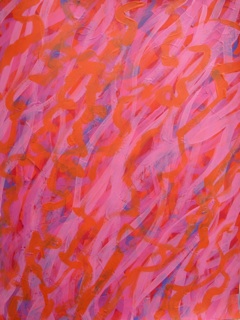
I keep imagining that some day I'm going to draw upon these abstract textures for painting a stopmo backdrop.
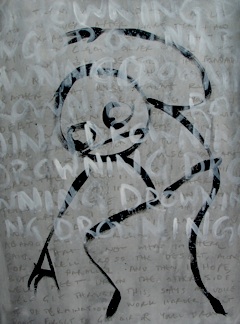
More use of text as texture.
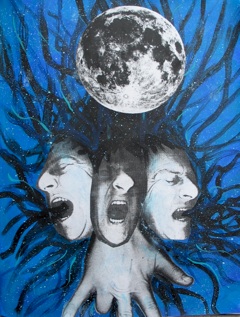
The weirdest part about doing this painting was snipping off fingers from the photocopies of my hands. I've still got at least one hanging around, which I'd like to use in a future piece.
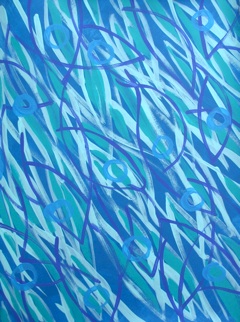
I did this one while staying up all night on New Year's Eve, waiting to see the first sunrise of the year. Contrary to what I'd thought, the loopiness of being sleep-deprived didn't make me feel looser and more creative… Rather, exhaustion poisoned the process, and sucked all the fun out of doing art that night.
posted by sven | permalink | categories: painting, sketchbook
March 30, 2009
portrait of ben hall
by sven at 7:00 am
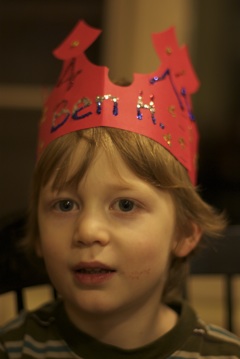
A while back I did a birthday portrait of my friend Michael Hall. Alison, his wife, liked it so much, I did a portrait for her, too. Their son Ben turned 5 on Jan 24… So, rounding out the family, I did a portrait for him.
As with the other paintings, I started with a photo.
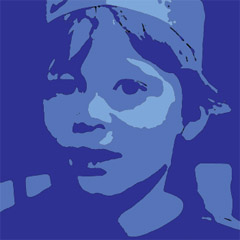
To get the 3-tone design, I spent a fair while in PhotoShop using Gaussian Blur and Posterize. I wound up cobbling together a bunch of different versions in order to get the clearest image.

I didn't imagine when I first painted mph's portrait that I'd be doing a whole series… It was very helpful to be able to borrow back Michael and Alison's portraits, so I could make sure Ben's fit nicely into the set.

Best wishes, Ben, Alison, Michael!
posted by sven | permalink | categories: painting
March 29, 2009
"dramatist's toolbox" class wraps up
by sven at 7:40 pm
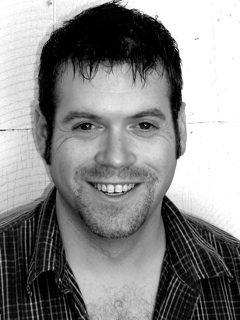
When my friend Kristen mentioned that she was going to take a playwriting class, I felt a sudden, powerful wave of envy. I want to take that class too!
If I were being good, the time probably ought to have gone toward completing Let Sleeping Gods Lie. But for the past year I’ve obsessively studied books about how to create stories for stage, screen, and literary publication… The opportunity to put theory into practice was just too good to miss.
So I signed up for director/playwright Matt Zrebski's “Dramatist's Toolbox” class, offered through Portland Center Stage’s GreenHouse program. For eight weeks, from January 31 to March 21, we gathered on the third floor of the Armory each Saturday morning at 9:00AM… And I had a blast!
Each week we had to write a 10-minute play. My first few attempts didn't quite gel… But by the end, I had four that satisfied me as being complete, coherent pieces.
Last weekend was the final class. As a means of bringing the experience to closure, I'm putting my plays into booklet format. I'll be giving them away as freebies to blog readers in the near future -- stay tuned!
Matt teaches a sequence of three classes: "Dramatist's Toolbox," "Play Sculpture," and "Play Tuning." If you're interested in getting theatrical ink onto paper, I recommend them. Matt's fun, his classes are affordable, and he doesn't waste any time getting you into motion. Hurry -- his next class begins April 6!
posted by sven | permalink | categories: classes & workshops
March 27, 2009
get well soon, chloe!
by sven at 7:00 am
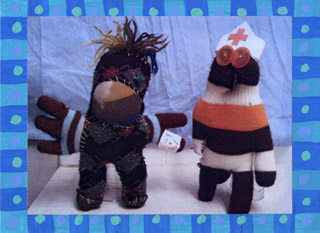
Chloe has broken her wrist! When Toby heard that she has to wear a cast, he wanted one too… As a show of sympathy. (Or so he says.)
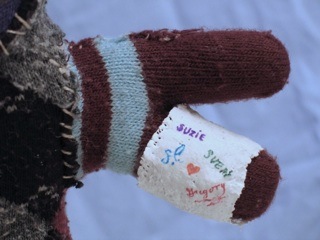
So Nurse Gregory dutifully made Toby a plaster bandage cast… And we all signed it.
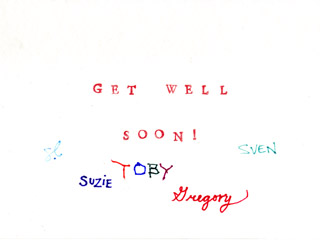
From everyone up here in Portland: get well soon, Chloe!
posted by sven | permalink | categories: miscellany
March 26, 2009
writing 10-minute plays for stopmo
by sven at 11:27 am
[An essay I wrote to some friends on 3/11.]
Most people agree that the most important aspect of a film is the story. If the story doesn't work, the film doesn't work. So for the past 15 months I've been studying the construction of story.
Before I go any farther… I'd just like to emphasize that dramatic stories are not the only legitimate type of film. For example, some films provide an experience that is primarily aesthetic… If there are characters at all, they're often anonymous, enigmatic, silent; there may be no discernible conflict or climax; but at the end of the film you wind up feeling like you glimpsed something beautiful, nonetheless. Traditional stories with understandable characters, dramatic conflicts, beginnings, middles, and ends, tend to be most popular -- and not without cause… But even though I neglect to discuss other species of filmic experience here, please don't think I'm putting them down!
Back to topic… My research on story has encompassed three art forms: film, literature, and theater. Research tends to start broad; then, as you clarify exactly what it is that you want to know, your scope narrows. So it has been for me…
1. LONG-FORM VS. SHORT-FORM
Film, literature, and theater each have strong internal divisions between long-form and short-form works. In film, there are "feature length" films and "shorts." In literature there are "novels" and "short stories." In theater there are full-length "plays" and there are "one-acts."
The construction of a long-form work in any medium is significantly different from that of a short-form work. Yet, I find it very interesting that how-to books about how to write short films, short stories, and one acts are quite rare. The vast majority of how-to books deal only with long-form works. Some books -- much to my irritation -- even promise to deal with short-form, but then just rehash long-form principles. [E.g. "Writing The Short Story" by Jack M. Bickham.]
At this point in time, I've narrowed my research to focus only on short-form fiction. For literature, I'm reading the monthly magazine, "Fantasy & Science Fiction." For animation, I've been studying Mike Judge & Don Hertzfeldt's The Animation Show anthologies and Acme Filmworks' "The Animation Show of Shows" series (Animation World Network store ). For plays, I've been reading the annual The Best Ten-Minute Plays series, edited by Lawrence Harbison.
A word of caution, though. It seems that the people who care most about the underlying principles of story are those who work in long-form. My sense is that it's just a lot harder to successfully produce long-form work without a strong understanding of structure -- so long-form folks have been forced to develop better theory.
Top picks for long-form how-to books… Screenplays: Story by Robert McKee. Literature: Techniques of the Selling Writer by Dwight V. Swain -- runner up The Art of Fiction by John Gardner. Playwriting: The Playwright's Process by Buzz McLaughlin -- runner up The Dramatist's Toolkit by Jeffrey Sweet.
Note: In my experience so far, screenwriters have the weakest understanding of story. It feels to me like the field is infected with a number of gimick-based methodologies that may in fact help you to doctor an existing script -- but that are rotten foundations on which to build your basic understanding of story. Beware!
2. WHAT'S MOST USEFUL TO STOPMOES: FILM, LITERATURE, OR PLAYS?
I've become convinced that the most useful medium for stopmoes to study is theater. Why?
The biggest reason: limited number of sets. With films, you can easily have the story take place in 80-150 locations. It's no big deal, because typically existing locations can be used. You don't have to build everything from scratch, as with plays and with stopmo. Plays tend to have just 1-3 major sets… Or perhaps merely imply their sets by using "black box" technique. Given the time entailed in building miniature props and sets, stopmoes have to be conservative.
Another reason: only concrete actions are allowed. With literature, you can do amazing things with adjectives and metaphors: e.g. "the wounded leaf somersaulted down to the ground like a football player who's just been shot in the ankle." There's no easy way to translate this poetry to the screen.
Similarly, you can get away with a good deal more inner monologue in literature… Granted, with film and theater you can do voice-overs or break the fourth-wall (having actors talk directly to the audience)… But generally it is ill-advised to do so, because you're violating the principle of "show, don't tell."
Now, theater is not a perfect model for stopmoes. There's a heavy emphasis on dialogue in theater… Remember that most audience members are going to be 50+ feet away from the actors and only get to see the action from one vantage point. Stopmoes would be well-advised to exploit our ability to provide cinematic close-ups and different camera angles. We should also try to convey information through purely visual means wherever possible -- both because we're working in a more visual medium, and because of how laborious it is to do lipsync.
Despite these caveats, it seems to me that the beginning assumptions of a playwright are most like those of someone writing for stopmo: don't use too many sets or characters, and tell the story purely through observable actions and dialogue.
3. 10-MINUTE PLAYS: SCALE
There is a genre in theater called the "10-minute play." It's been around since the early 70s. There are a number of national competitions, which have subsequently resulted in several book anthologies. "One acts" can easily run a half-hour long -- so 10-minute plays are generally an even shorter form. For most purposes, one page of dialogue is equated to one minute of stage time (cold reading format, not the format you see published in books). Thus, ten minutes = ten pages.
It seems to me that 10 minutes is about as much as most independent, amateur stopmo filmmakers should shoot for in their projects. Consider the following estimates…
Aardman films expects 4 seconds of finished animation per day from their animators. If you work backwards, you can see that the way they arrived at this benchmark was by allowing animators 5 minutes per shot, shooting at 24fps, over the course of an 8-hour work day. Now, if you shoot at 12fps and are maybe a little looser with your poses, you might be able to get 10 seconds per day -- presuming you can put in 8 hours. Working full-time, then you could accomplish roughly one minute of film per week. Ten minutes of film = ten weeks. Basically a quarter year (13 weeks)… Though mind you, that's not counting puppet and set fabrication, lip sync analysis, and the actual scriptwriting.
Still, a ten-minute film in a quarter year sounds excellent. Can't work full time? If you can do 10 hours each weekend, you can still get the project done by year end. Thus, 10-minute plays are a pretty good match for stopmo animators in terms of scale.
4. 10-MINUTE PLAYS: AESTHETIC
Remember Sturgeon's Law: "ninety percent of everything is crap." I've found this to be very much true even in the annual "The Best Ten-Minute Plays" series.
But actually, this is part of what attracted me to the series. I don't want to read an anthology of the best 10-minute plays ever, with all the crap taken out… I want a sense of who the "competition" is right now. I want to know about the overall quality of contemporary playwrights working in this form -- not be bedazzled by the best of the best, whom I have little hope of ever rivaling. I want to learn from failures and triumphs in roughly equal measure.
The "Best Ten-Minute Plays" series I've been reading is also interesting because for each year (since 2004), two books are put out: one for "2 actors," one for "3 or more actors." In my opinion, the plays with 3+ actors tend to be better. Having 3+ characters seems to set up conflict more easily, and prompts more interesting scenarios. Plays with two random strangers who start spouting observations about one another out of the blue -- well, I find them pretty intolerable.
So, suppose you were to take the best of the 10-minute plays and try to do them in stopmo… Would it work?
I've been worrying about this. Part of the unique charm of stopmo is that you can do things that are unrealistic. You can use fantasy monsters, purple characters with ridiculously proportioned anatomy, cartoony physics, etc. I don't want to completely abandon such stuff.
It's not impossible to write some of these things into stage plays, though. As for character design, think about the absurd costumes that Julie Taymor used in "Fool's Fire" -- or the giant puppets she employed in "The Lion King" or "Grendel." Most 10-minute plays are written with black box sets in mind; brevity means that you're probably not going to make a big investment in sets & props. But just because it's uncommon, doesn't mean there's any reason why the 10-minute format inherently prohibits such things.
The thought experiment that finally resolved this question for me: What if I cast one of the 10-minute plays I've written with characters from "Coraline"? I have a play I've written titled "The Buried Piano." Suppose Coraline played "Gina", Coraline's Dad played "Howard", Coraline's mother played "Ellie", and Ms. Forcible played "Ursula"…
Would it work? YES! It's a particular sort of stopmo film -- one that emphasizes character acting -- but that's an aesthetic that's already been established in the world of stop-motion films.
5. WRITING FOR 10-MINUTE PLAYS
This is a topic for a much longer essay -- but I want to at least touch on what I've been learning about playwriting through doing assignments for my "Dramatist's Toolbox" class, taught by Matt Zrebski.
Central Spectacle
Like Jose Rivera, "everything that I write comes from some kind of image." (The Art & Craft of Playwriting, by Jeffrey Hatcher, p.196) I seem to start from "spectacle" -- some image that excites my imagination. Maybe it can be shown on stage, or maybe the actors put it into my head via dialogue… The head of Orpheus kept in a box. A taxidermied whale hanging from the ceiling of a dance club. A buried piano. A nuclear bomb that's been painted with murals.
Finding my central spectacle almost needs to be an illogical process. It's a matter of juxtaposing images collage-style until I find something that really leaps out at me with poetic portent. Understanding why the image "sings" comes later.
Character Generation
You need characters for the play. Generating characters has turned out to be much easier than I expected. A very useful exercise: Go to Google Images and surf around collecting head shots of people… Male, female, young, middle-aged, old, various ethnicities. Print the photos out, one per piece of 8.5x11" paper. Pick one out at random and then spend ten minutes on a free write. Focus most on what they value and what they might desire. It took me about 2 hours to gather 40 faces, and about another 2 hours to generate 10 characters.
Conect-The-Dots
I'm finding that playwriting is largely a matter of "connect-the-dots." You find a central spectacle that you like… You pick a couple of characters that you're attracted to… Now you play the "what if?" game, brainstorming, trying to find scenarios that bring your elements into play with one another.
For me, a really useful tool has been to look for three different interpretations of the central spectacle. For instance: maybe a buried piano is an archeological artifact to put on display; maybe it's a seed that will grow into a piano tree one day; maybe it's the manifestation of a song that's rotting in the ground.
It doesn't matter to me if the interpretations are literally impossible. I find I'm working more or less in the genre of "magic realism". What's most important to me is that my plays convey a sense of poetry and examine how to transform the ugly or banal into the transcendent. [Kinda sounds like an artist's statement, eh?]
Figure out what your climax is before you leave the pre-work phase and start writing the actual play. The climax probably has a strong relationship with your core spectacle. If you don't have a powerful moment to end on, don't even begin!
Refining Characters
Each of the characters in the play must be substantially different from the others. Each should be at least a little eccentric -- including the main character (oddly the person that writers often characterize last).
Each character has to have a literal function in the story world… But, for me, the play really gels when I discover how each character maps onto a different aspect of the theme. For instance, one character sees the buried piano as something to put in the museum, another wants to play it… And so on.
You can create backstory for your characters ad nauseam. However, in practice, you draw on most of that material only infrequently. Story people tend to boil down to just a few key traits. As an exercise, pick just three adjectives that best describe each character.
Figure out who your main character is. When you're juggling 3 or 4 characters, it's easy to forget about this. You don't necessarily have to shout at the audience "this is my main character!" -- but you absolutely need to pick one person. Why? Because what their core need is will determine the "story question" -- and you're going to have to check yourself to make sure that the ending of the story actually answers the question raised at the beginning.
Discovering the Conflicts
Know what each character wants. This is how you develop conflict. Look for ways to make each character's desires incompatible. It can be useful to identify your main antagonist -- but there's no reason why they have to be a "villain," and you may well wind up having several characters who are at odds with the main character. Ex: the piano can't be played right now because there's a party going on, and the state governor's present.
Conflict need not be about personality. Each of your characters can be a nice person, essentially -- it's just that they have a different vision than the protagonist. Wage conflict over possessions. Who possesses the car? Who's in charge of the party? Who has control of the romantic interest? If your main character starts the play in possession of the thing they want, you've got a problem. Either find a way to put the mcguffin in the possession of another character, or choose someone else from your cast to be the main character.
Summary
Story is really only made out of a few elements: the core poetic image/spectacle/theme, characters, conflicting desires, and a good climax. Make sure you have one main character who wants possession of an object/place/tool/person; find reasons why your other characters have a different vision for this mcguffin. Make sure the resolution of the play answers the same question posed at the beginning of the play.
That's about it. Now… Go!
Give me one 10-page script each week for 8-13 weeks. And then pick one of them for your stopmo film. (See where I'm going with all this?)
posted by sven | permalink | categories: stopmo, writing
March 14, 2009
mustache week: the grandpa
by sven at 7:00 am

HO HO HO! MERRY CHRISTMAS, EVERYONE!
(Um, Toby? It's not Christmas.)
WHY NOT?! EVERY DAY SHOULD BE CHRISTMAS! IT'S CHRISTMAS IN MY HEART! I LOVE YOU SVEN!
(Um, love you too Tobles.)
…Thus concludes mustache week 2009. Happy mustache everyone!
posted by sven | permalink | categories: miscellany, toby
March 13, 2009
mustache week: the sheriff
by sven at 7:00 am
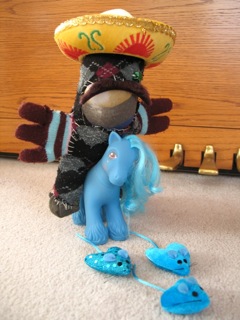
Toby says: GIT ALONG LITTLE MOUSIES! WE'RE GOING TO CUPCAKEVILLE! SPRINKLES FOR ALL!!
posted by sven | permalink | categories: miscellany, toby
March 12, 2009
mustache week: the weasel
by sven at 7:00 am
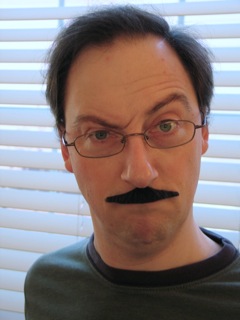
Ya wanna buy a used car? Sure, I can help ya!
…But with that credit? And you want tires? I'm gonna have to talk to my manager.
posted by sven | permalink | categories: miscellany
March 11, 2009
mustache week: the bruiser
by sven at 7:00 am

Still life with mustache. (An homage to Edward Gorey.)
posted by sven | permalink | categories: miscellany
March 10, 2009
mustache week: the square
by sven at 7:00 am
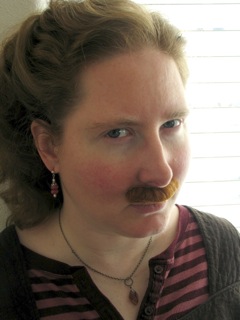
Gretchin has her eye on you, Mister! You think you're smart -- but you're not going anywhere in life if you don't learn your algebra.
posted by sven | permalink | categories: miscellany
March 9, 2009
mustache week: the hero
by sven at 7:00 am
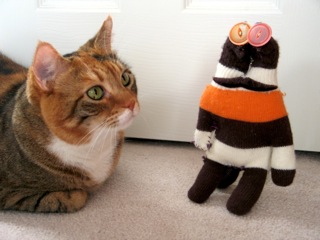
Gregory and Cleo recount their past years of elephant hunting in Africa. "Oh, good show old chap!"
posted by sven | permalink | categories: miscellany, toby
March 8, 2009
mustache week: the hollywood
by sven at 7:00 am

Susie, our crocheted octopus friend, occasions the streets of Venice with her accordion.
posted by sven | permalink | categories: miscellany
March 6, 2009
mustache week
by sven at 7:00 am
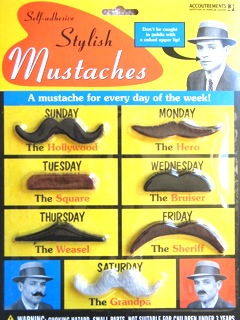
For Christmas, my brother sent us a pack of fake mustaches. Now, I know International Mustache Month is properly in February… But heck -- any day's a good day for a fake mustache!
We'll be abiding by the labels on the package, and thus begin our EPIC JOURNEY on Sunday. Stay tuned!
posted by sven | permalink | categories: miscellany
March 5, 2009
lsgl: roughing out shots
by sven at 3:57 pm
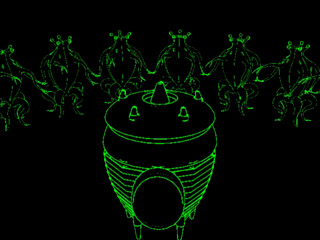
I've been giving everything I've got to learning the art of playwriting. I'm in a class taught by playwright Matt Zrebski, and have been completing a 10-page play every week. Consequently, in February I only put one day in on Let Sleeping Gods Lie… But it was a good one.
I did a new thumbnail storyboard for acts 2, 3, & the epilogue. With a little photocopy magic, I've managed to put the whole story on one 8.5x11" piece of paper now. It's really nice to be able to view the whole thing at once, rather than having to go back and forth between the several huge pieces of foamcore I've been using.
I expect there will be further tweaks to the imagery… But I think the storyboard is good enough now to get back in motion.
I'll be using a method that served me well last year: roughing out stand-in shots. I'll be using simple pyramids to represent galloping Elder Things. I'll be doing renders at 160x120 pixel resolution. Time-wise, make mistakes as inexpensive as possible -- that's the name of the game.
posted by sven | permalink | categories: let sleeping gods lie
March 4, 2009
see "gerald's last day"
by sven at 11:59 pm
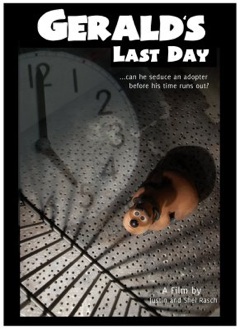
Our stopmo friends Justin Rasch and Shel Wagner-Rasch have produced a wonderful film titled Gerald's Last Day.
It was a family effort -- their daughter Aedon does the voice of the little girl, Shel did puppet fab, Justin animated… The film's been winning lots of awards on the festival circuit. As they say, "it couldn't happen to nicer people."
Justin's talent really brings Gerald to life. He makes you feel the poor pup's plight…
For a limited time you can see the film online at the Delta Airlines Fly-In Movie Competition. Please go and give it a gander… And if you like it as much as I do, then give it a vote of five stars to help it win. You don't have to sign up for anything.
posted by sven | permalink | categories: exhibits & events, stopmo